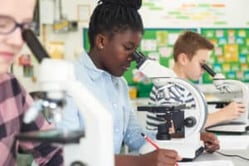Physical and Chemical Changes Lesson Plan – A Complete Science Lesson Using the 5E Method of Instruction
By the end of this lesson about physical and chemical changes, students will be able to investigate how evidence of chemical reactions indicate that new substances with different properties are formed. Each lesson is designed using the 5E method of instruction to ensure maximum comprehension by the students. Each of our lessons is designed using the 5E method of instruction to ensure maximum comprehension by the students. This well-thought out unit does the heavy lifting, giving teachers easy-to-implement, highly engaging lesson plans.
This blog will walk you through each of the steps and activities from the Physical and Chemical Changes 5E Lesson Plan.
ENGAGEMENT
Objective Introduction
At the beginning of the lesson, the class will do a Think-Pair-Share to discuss the objective.
Class Activity
- Have a student come to the front of the board and tear a piece of paper into pieces.
- Have another student try to put the paper back together on the table.
- Next, the teacher will burn a small piece of paper.
- Have a student try to put the burned paper back together.
Student Activity
- Ask the students to explain the difference in the two pieces of paper.
- What was it that made the burned paper different?
- Which demonstration represented a chemical change?
- Which demonstration represented a physical change?
- What is the difference in a physical and chemical change?
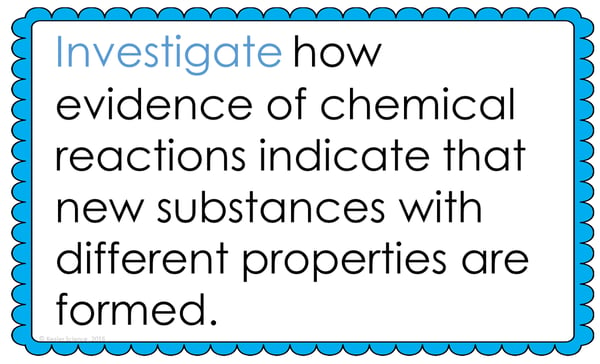
The teacher will then help to clear any misconceptions their students have about chemical changes. A common but major misconception, for example, is that students may incorrectly assume that all changes to matter can be reversed.
Estimated Class Time for the Engagement: 20-30 minutes
EXPLORATION
With nine stations in total, you can introduce physical and chemical changes to your middle school students in a variety of ways! Four of these stations are considered input stations where students will learn new information about physical and chemical changes, and four of the stations are output stations where students will be demonstrating their mastery of the lesson's material. A bonus station offers challenges for your early finishers and independent learners. You can read more about how I set up the station labs here.
Watch It!
At this station students will be watching a five minute video explaining the evidence of a chemical change, starring the one and only… BILL BILL BILL BILL… Bill Nye the Science Guy. Students will then answer some questions relating to the video and record their answers on their lab station sheet. For example, List three demonstrations from the video that showed evidence of a chemical change. Explain what a chemical reaction is. Which subatomic particle is specifically responsible for combining the atoms together to form a new substance?
Read It!
This station will provide students with a one-page reading about chemical and physical changes. In the reading, students will discover many the differences between a physical and chemical change. Students will be introduced to how chemical changes go as far down as the atomic level. There are four follow-up questions that the students will answer to demonstrate their comprehension of the reading material.
Explore It!
Students will be working in pairs to observe the five pieces of evidence of a chemical change. Students will have to follow the directions on the task cards and using lab materials to show how some evidence of chemical changes. Students will be demonstrating evidence of gas with bubbles and the formation of a new substance with fire.
Research It!
The research station will allow students to interact with ***broken link*** (Link worked for me! -Janica)
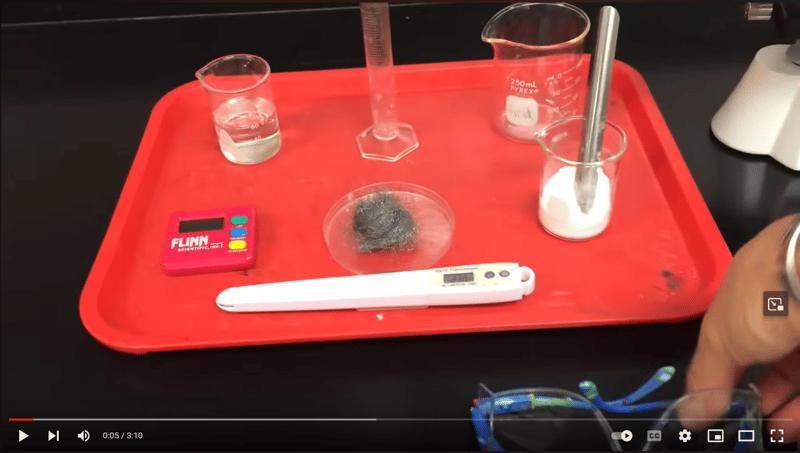
Organize It!
The organize it station allows your students to place cards in the correct column by whether the information is describing either a chemical change and a physical change.
Illustrate It!
Your visual students will love this station. Students will draw five images that represent evidence of a chemical change. Examples: color change, temperature change, production of gas, fire, precipitate.
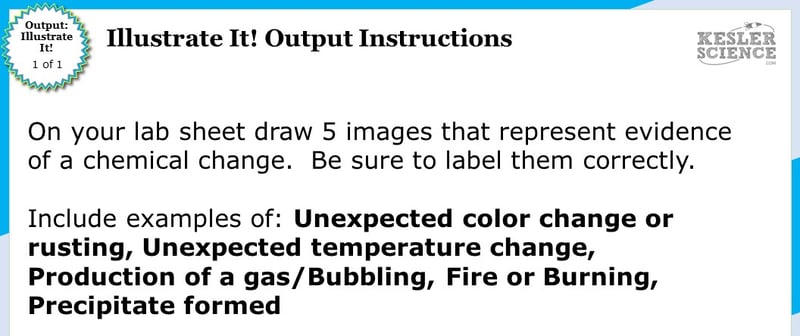
Write It!
Students who can answer open-ended questions about the lab truly understand the concepts that are being taught. At this station the students will be answering three task cards like: Describe how you know a chemical change has taken place? What is a physical change? What is a chemical change?
Assess It!
The Assess It station is where students will go to prove mastery over the concepts they learned in the lab. The questions are setup in a standardized format with multiple choice answers. Some questions will ask students: Which of the following would not be evidence of a chemical change? What type of change is happening? What evidence proves this process is a chemical change? What evidence proves a chemical reaction occurred?
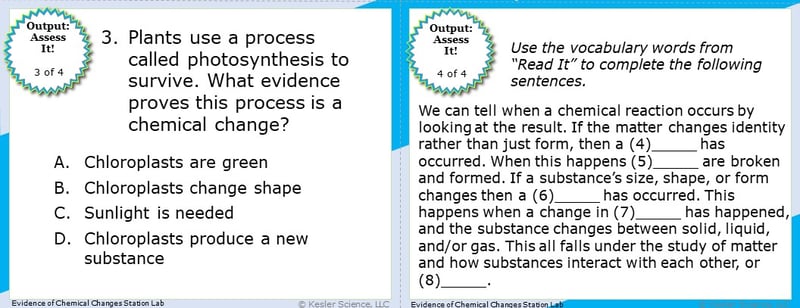
Challenge It! - Bonus Station
Early finishers and advanced students will love the extension activities in this station. Four activity choices offer them ways to expand their learning through mini-games and mini-projects.
Estimated Class Time for the Exploration: One or two 45-minute class periods
EXPLANATION
The explanation activities will become much more engaging for your class once they’ve completed the exploration station lab. During the explanation piece of the lesson, the teacher will be clearing up any misconceptions their students may have about physical and chemical changes with a variety of materials. These materials include on-level and modified versions of the interactive presentation (may be used individually or projected), anchor charts, and paper or digital interactive notebook activities. If you have students that need modified notes, the 5E lessons come equipped to help give every student access to the lesson.
Interactive notebook samples: Above-left is a digital INB activity slide; above-right is an example of the paper INB activities.
The students will also be interacting with their journals using INB templates for chemical changes. Each INB activity is designed to help students compartmentalize information for a greater understanding of the concept. The chemical changes INB template allows students to focus their notes on identifying the differences between physical and chemical changes.
Estimated Class Time for the Exploration: Two or three 45-minute class periods
ELABORATION
The elaboration section of the 5E method of instruction gives students choices that allow them to prove they’ve mastered the concepts behind the lesson. When students are given a choice, they’re much more enthusiastic and invested in the project than they are when their teachers choose their projects for them. There are a total of nine choices to demonstrate understanding of physical and chemical changes. A separate set of choices that offer more teacher support are also available for students that need them. Rubrics guide students to doing their best work and assist in grading.

Estimated Class Time for the Elaboration: Two or three 45-minute class periods (can also be used as an at-home project)
EVALUATION
The final piece of the 5E model is to evaluate your students' comprehension. Included in every 5E lesson is a homework assignment, assessment, and modified assessment. Research has shown that homework needs to be meaningful and applicable to real-world activities in order to be effective. When possible, I like to give open-ended assessments to truly gauge the student’s comprehension.
Estimated Class Time for the Elaboration: One 45-minute class period
DOWNLOAD THE FULL LESSON NOW
Download Over $100 in FREE Resources
For Middle School Science
Simply create a login below and gain immediate access to a selection of our Kesler Science product line worth $100 - for FREE. There's a full version of every product type! You'll also join tens of thousands of middle school science teachers who receive timely tips and strategies straight to their inbox.







